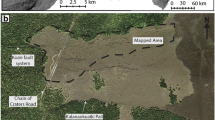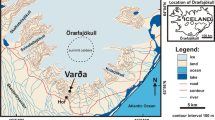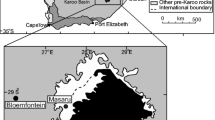Abstract
Observations in the USA, Iceland and Tenerife, Canary Islands reveal how processes occurring during basaltic eruptions can result in complex physical and stratigraphic relationships between lava and proximal tephra fall deposits around vents. Observations illustrate how basaltic lavas can disrupt, dissect (spatially and temporally) and alter sheet-form fall deposits. Complexity arises through synchronous and alternating effusive and explosive activity that results in intercalated lavas and tephra deposits. Tephra deposits can become disrupted into mounds and ridges by lateral and vertical displacement caused by movement (including inflation) of underlying pāhoehoe lavas and clastogenic lavas. Mounds of tephra can be rafted away over distances of 100 s to 1,000 s m from proximal pyroclastic constructs on top of lava flows. Draping of irregular topography by fall deposits and subsequent partial burial of topographic depressions by later lavas can result in apparent complexity of tephra layers. These processes, deduced from field relationships, have resulted in considerable stratigraphic complexity in the studied proximal regions where fallout was synchronous or alternated with inflation of subjacent lava sheets. These mechanisms may lead to diachronous contact relationships between fall deposits and lava flows. Such complexities may remain cryptic due to textural and geochemical quasi-homogeneity within sequences of interbedded basaltic fall deposits and lavas. The net effect of these processes may be to reduce the usefulness of data collected from proximal fall deposits for reconstructing basaltic eruption dynamics.










Similar content being viewed by others
References
Barry TL, Self S, Kelley SP, Reidel S, Hooper P, Widdowson M (2010) New 40Ar/39Ar dating of the Grande Ronde lavas, Columbia River basalts, USA: implications for duration of flood basalt eruption episodes. Lithos 118:213–222
Bonadonna C, Houghton BF (2005) Total grain-size distribution and volume of tephra fall deposits. Bull Volcanol 67:441–456
Branney MJ, Kokelaar P (2002) Pyroclastic density currents and the sedimentation of ignimbrites. Geol Soc Lond Mem 27:1–152
Brown RJ, Blake S, Thordarson T, Self S (2014) Eruption processes, pyroclastic deposits and volcanic edifices of flood basalt fissure eruptions (The Roza Member, Columbia River Basalt Province, US). Geol Soc Am Bull 126:875–891
Carey S, Sparks RSJ (1986) Quantitative models of the fallout and dispersal of tephra from volcanic eruption columns. Bull Volcanol 48:109–125
Carracedo JC (2013) The last 2 ky of eruptive activity of the teide volcanic complex: features and trends. In: Troll VR, Carrecedo JC (eds) Teide volcano. Springer, Berlin, pp 129–153
Carracedo JC, Rodriguez Badiola E, Solera V (1992) The 1730–1736 eruption of Lanzarote, Canary Islands: a long, high-magnitude basaltic fissure eruption. J Volcanol Geotherm Res 53:239–250
Duraiswami RA, Bondre NR, Managave S (2008) Morphology of rubbly pāhoehoe (simple) flows from the Deccan volcanic province: implications for style of emplacement. J Volcanol Geotherm Res 177:822–836
Fedotov SA, Chirkov AM, Gusev NA, Kovalev GN, Slezin Yu B (1980) The large fissure eruption in the region of Plosky Tolbachik volcano in Kamchatka, 1975–1976. Bull Volcanol 43:47–60
Gudmundsson A, Oskarsson N, Gronvold K, Saemundsson K, Sigurdsson O, Stefansson R, Gislason SR, Einarsson P, Brandsdottir B, Larsen G, Johannesson H, Thordarson T (1992) The 1991 eruption of Hekla, Iceland. Bull Volcanol 54:238–246
Guilbaud M-N, Self S, Thordarson T, Blake S (2005) Morphology, surface structures, and emplacement of lavas produced by Laki, A.D. 1783-1784. Geol Soc Am Spec Pap 396:81–102
Heliker C, Kauahikaua J, Sherrod DR, Lisowski M, Cervelli P (2003) The rise and fall of Puʻu ʻŌʻō Cone, 1983-2002. In: Heliker C, Swanson DA, Takahashi TJ (eds) Puʻu ‘Ōʻō-Kūpainaha eruption, Kīlaeua volcano, Hawai’i: the first 20 years. USGS Prof Paper 1676:29–52
Holm RF (1987) Significance of agglutinate mounds on lava flows associated with monogenetic cones: an example at Sunset Crater, northern Arizona. Geol Soc Am Bull 99:319–324
Hon K, Kauahikaua J, Denlinger R, Mackay K (1994) Emplacement and inflation of pāhoehoe sheet flows: observations and measurements of active lava flows on Kīlauea volcano, Hawai’i. Geol Soc Am Bull 106:351–370
Houghton BF, Bonadonna C, Gregg CE, Johnston DM, Cousins WJ, Cole JW, Del Carlo P (2006) Proximal tephra hazards: recent eruption studies applied to volcanic risk in the Auckland volcanic field, New Zealand. J Volcanol Geotherm Res 155:138–149
Keszthelyi L, Thordarson T, McEwen A, Haack A, Guilbaud MN, Self S, Rossi MJ (2004) Icelandic analogs to Martian flood lavas. Geochem Geophys Geosyst 5:Q11014. doi:10.1029/2004GC000758
Lopez T, Thomas HE, Prata AJ, Amigo A, Fee D, Moriano D (2014) Volcanic plume characteristics determined using an infrared imaging camera. J Volcanol Geotherm Res 300:148–166
Martin BS (1989) The Roza Member, Columbia River Basalt Group: chemical stratigraphy and flow distribution. In: Reidel SP, Hooper PR (eds) Volcanism and tectonism in the Columbia River flood basalt province. Geol Soc Am Spec Paper 239:85–104
Parcheta CE, Houghton BF, Swanson DA (2012) Hawaiian fissure fountains 1: decoding deposits—episode 1 of the 1969–1974 Mauna Ulu eruption. Bull Volcanol 74:1729–1743
Parfitt EA, Wilson L (1999) A Plinian treatment of fallout from Hawaiian lava fountains. J Volcanol Geotherm Res 88:67–75
Passmore E, Maclennan J, Fitton G, Thordarson T (2012) Mush disaggregation in basaltic magma chambers: evidence from the AD 1783 Laki eruption. J Pet 53:2593–2623
Pioli L, Azzopardi BJ, Cashman KV (2009) Controls on the explosivity of scoria cone eruptions: magma segregation at conduit junctions. J Volcanol Geotherm Res 186:407–415. doi:10.1016/j.jvolgeores.2009.07.014
Pyle DM (1989) The thickness volume and grainsize of tephra fall deposits. Bull Volcanol 51:1–15
Richter DH, Eaton JP, Murata KJ, Ault WU, Krivoy HL (1970) Chronological narrative of the 1959–60 eruption of Kīlauea volcano, Hawai’i. In: The 1959–60 eruption of Kīlauea volcano, Hawai’i. US Geol Surv Prof Pap 537-E:E1–E73
Riggs NR, Duffield WA (2008) Record of complex scoria cone eruptive activity at Red Mountain, Arizona, USA, and implications for monogenetic mafic volcanoes. J Volcanol Geotherm Res 178:763–776
Rowland SK, Jurado-Chichay Z, Ernst G, Walker GPL (2009) Pyroclastic deposits and lava flows from the 1759–1774 eruption of El Jorullo, Mexico: aspects of ‘violent Strombolian’ activity and comparison with Parícutin. In: Thordarson T, Self S, Larsen G, Rowland SK, Hoskuldsson A (eds) Studies in volcanology: the legacy of George Walker. Special Publications of IAVCEI, Geol Soc London 2:105–128
Self S, Widdowson M, Thordarson T, Jay AE (2006) Volatile fluxes during flood basalt eruptions and potential effects on the global environment: a Deccan perspective. Earth Planet Sci Lett 248:518–532
Sigmarsson O, Condomines M, Gronvold K, Thordarson T (1991) Extreme magma homogeneity in the Laki 1783-84 Lakagigar eruption: origin of a large volume of evolved basalt in Iceland. Geophys Res Lett 18:2229–2232
Swanson DA, Wright TL, Helz RT (1975) Linear vent systems and estimated rates of magma production and eruption for the Yakima basalt of the Columbia plateau. Am J Sci 275:877–905
Thordarson T, Self S (1993) The Laki (Skaftár Fires) and Grímsvötn eruptions in 1783–1785. Bull Volcanol 55:233–263
Thordarson T, Self S (1996) Sulfur, chlorine and fluorine degassing and atmospheric loading by the Roza eruption, Columbia River Basalt Group, Washington, USA. J Volcanol Geotherm Res 74:49–73
Thordarson T, Self S (1998) The Roza Member, Columbia River Basalt Group: a gigantic pāhoehoe lava flow field formed by endogenous processes. J Geophys Res 103:27,411–27,445
Valentine GA, Perry FV, Krier D, Keating GN, Kelley RE, Coghill AH (2006) Small-volume basaltic volcanoes: eruptive products and processes, and post-eruptive geomorphic evolution in Crater Flat (Pleistocene), southern Nevada. Geol Soc Am Bull 118:1313–1330
Vye-Brown C, Gannoun A, Barry TL, Self S, Burton KW (2013) Osmium isotope variations accompanying the eruption of a single lava flow field in the Columbia River Flood Basalt Province. Earth Planet Sci Lett 368:183–194
Walker GPL (1991) Structure, and origin by injection of lava under surface crust, of tumuli, “lava rises”, “lava-rise pits”, and “lava-inflation clefts” in Hawaii. Bull Volcanol 53:546–558
Wilson L, Walker GPL (1987) Explosive volcanic eruptions—VI. Ejecta dispersal in Plinian eruptions: the control of eruption conditions and atmospheric properties. Geophys J Int 89:657–679
Acknowledgments
Research in the CRBG was funded by a Natural Environment Research Council Standard Grant (NE/E019021/1) awarded to S. Self. T. Thordarson was partly funded by NASA and the University of Hawaiʻi. We thank C. Parcheta and S. Rowland for positive and constructive reviews and M. Patrick for editorial assistance and advice.
Author information
Authors and Affiliations
Corresponding author
Additional information
Editorial responsibility: M.R. Patrick
Rights and permissions
About this article
Cite this article
Brown, R.J., Thordarson, T., Self, S. et al. Disruption of tephra fall deposits caused by lava flows during basaltic eruptions. Bull Volcanol 77, 90 (2015). https://doi.org/10.1007/s00445-015-0974-3
Received:
Accepted:
Published:
DOI: https://doi.org/10.1007/s00445-015-0974-3




